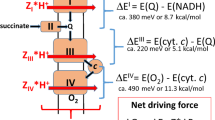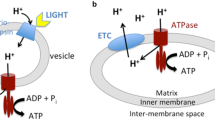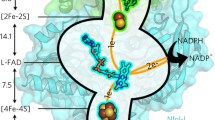Abstract
The core of this second article shows how logical errors and inconsistencies in previous theories of energy coupling in oxidative phosphorylation are overcome by use of a torsional mechanism and the unified theory of ATP synthesis/hydrolysis. The torsional mechanism is shown to satisfy the pioneering and verified features of previous mechanisms. A considerable amount of data is identified that is incompatible with older theories but is now explained in a logically consistent and unified way. Key deficiencies in older theories are pinpointed and their resolution elucidated. Finally, major differences between old and new approaches are tabulated. The new theory now provides the elusive details of energy coupling and transduction, and allows several novel and experimentally verifiable predictions to be made and a considerable number of applications in nanotechnology, energy conversion, systems biology, and in health and disease are foreseen.
Similar content being viewed by others
References
Brierley GP (1970) Energy-linked alteration of the permeability of heart mitochondria to chloride and other anions. Biochemistry 9:697–707
Chance B, Mela L (1966) A hydrogen ion concentration gradient in a mitochondrial membrane. Nature 212:369–372
Gould JM, Cramer WA (1977) Relationship between oxygen-induced proton efflux and membrane energization in cells of Escherichia coli. J Biol Chem 252:5875–5882
Green DE (1981) A critique of the chemiosmotic model of energy coupling. Proc Natl Acad Sci USA 78:2240–2243
Jain S, Nath S (2000) Kinetic model of ATP synthase: pH dependence of the rate of ATP synthesis. FEBS Lett 476:113–117
Jain S, Murugavel R, Hansen LD (2004) ATP synthase and the torsional mechanism: Resolving a 50-year-old mystery. Curr Sci 87:16–19
Kaim G, Dimroth P (1999) ATP synthesis by F-type ATP synthase is obligatorily dependent on the transmembrane voltage. EMBO J 18:4118–4127
Massari S, Azzone GF (1970) The mechanism of ion translocation in mitochondria. 1. Coupling of K+ and H+ fluxes. Eur J Biochem 12:301–309
Mitchell P (1966) Chemiosmotic coupling in oxidative and photosynthetic phosphorylation. Biol Rev 41:445–502
Mitchell P (1979) Keilin’s respiratory chain concept and its chemiosmotic consequences. Science 206:1148–1159
Mitchell P, Moyle J (1967) Respiration-driven proton translocation in rat liver translocation. Biochem J 105:1147–1162
Mitchell P, Moyle J (1969) Estimation of membrane potential and pH difference across the cristae membrane of rat liver mitochondria. Eur J Biochem 7:471–484
Nath S (1998) A thermodynamic principle for the coupled bioenergetic processes of ATP synthesis. Pure Appl Chem 70:639–644
Nath S (2002) The molecular mechanism of ATP synthesis by F1F0-ATP synthase: A scrutiny of the major possibilities. Adv Biochem Eng Biotechnol 74:65–98
Nath S (2003) Molecular mechanisms of energy transduction in cells: Engineering applications and biological implications. Adv Biochem Eng Biotechnol 85:125–180
Nath S (2004) The torsional mechanism of energy transduction and ATP synthesis as a breakthrough in our understanding of the mechanistic, kinetic and thermodynamic details. Thermochim Acta 422:5–17
Nath S (2006) A novel systems biology/engineering approach solves fundamental molecular mechanistic problems in bioenergetics and motility. Process Biochem 41:2218–2235
Nath S (2008) The new unified theory of ATP synthesis/hydrolysis and muscle contraction, its manifold fundamental consequences and mechanistic implications and its applications in health and disease. Int J Mol Sci 9:1784–1840
Nath S (2010) Beyond the chemiosmotic theory: Analysis of key fundamental aspects of energy coupling in oxidative phosphorylation in the light of a torsional mechanism of energy transduction and ATP synthesis—Invited Review Part 1. J Bioenerg Biomemb 42. doi:10.1007/s10863-010-9296-5
Nath S, Jain S (2002) The detailed molecular mechanism of ATP synthesis in the F0 portion of ATP synthase reveals a non-chemiosmotic mode of energy coupling. Thermochim Acta 394:89–98
Nath SS, Nath S (2009) Energy transfer from adenosine triphosphate: Quantitative analysis and mechanistic implications. J Phys Chem B 113:1533–1537
Nath S, Rohatgi H, Saha A (1999) The torsional mechanism of energy transfer in ATP synthase. Curr Sci 77:167–169
Pozzan T, Azzone GF (1976) The coupling of electrical ion fluxes in rat liver mitochondria. FEBS Lett 72:62–66
Pressman BC (1965) Induced active transport of ions in mitochondria. Proc Natl Acad Sci USA 53:1076–1083
Pressman BC, Harris EJ, Jagger WS, Johnson JH (1967) Antibiotic-mediated transport of alkali ions across lipid barriers. Proc Natl Acad Sci USA 58:1949–1956
Quagliariello E, Palmieri F, Prezioso G, Klingenberg M (1969) Kinetics of succinate uptake by rat-liver mitochondria. FEBS Lett 4:251–254
Tedeschi H (2005) Old and new data, new issues: The mitochondrial ΔΨ. Biochim Biophys Acta 1709:195–202
Tupper JT, Tedeschi H (1969) Mitochondrial membrane potentials measured with microelectrodes: Probable ionic basis. Science 166:1539–1540
Williams RJP (1979) Some unrealistic assumptions in the theory of chemi-osmosis and their consequences. FEBS Lett 102:126–132
Author information
Authors and Affiliations
Corresponding author
Rights and permissions
About this article
Cite this article
Nath, S. Beyond the Chemiosmotic Theory: Analysis of Key Fundamental Aspects of Energy Coupling in Oxidative Phosphorylation in the Light of a Torsional Mechanism of Energy Transduction and ATP Synthesis—Invited Review Part 2. J Bioenerg Biomembr 42, 301–309 (2010). https://doi.org/10.1007/s10863-010-9295-6
Received:
Accepted:
Published:
Issue Date:
DOI: https://doi.org/10.1007/s10863-010-9295-6




